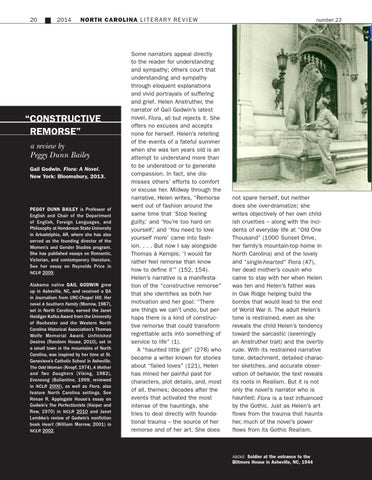20
2014
NORTH CAROLINA L I T E R A R Y RE V I E W
“Constructive Remorse” a review by Peggy Dunn Bailey Gail Godwin. Flora: A Novel. New York: Bloomsbury, 2013.
Peggy Dunn Bailey is Professor of English and Chair of the Department of English, Foreign Languages, and Philosophy at Henderson State University in Arkadelphia, AR, where she has also served as the founding director of the Women’s and Gender Studies program. She has published essays on Romantic, Victorian, and contemporary literature. See her essay on Reynolds Price in NCLR 2009. Alabama native Gail Godwin grew up in Asheville, NC, and received a BA in Journalism from UNC-Chapel Hill. Her novel A Southern Family (Morrow, 1987), set in North Carolina, earned the Janet Heidiger Kafka Award from the University of Rochester and the Western North Carolina Historical Association’s Thomas Wolfe Memorial Award. Unfinished Desires (Random House, 2010), set in a small town in the mountains of North Carolina, was inspired by her time at St. Genevieve’s Catholic School in Asheville. The Odd Woman (Knopf, 1974), A Mother and Two Daughers (Viking, 1982), Evensong (Ballantine, 1999; reviewed in NCLR 2000), as well as Flora, also feature North Carolina settings. See Renae R. Applegate House’s essay on Godwin’s The Perfectionists (Harper and Row, 1970) in NCLR 2010 and Janet Lembke’s review of Godwin’s nonfiction book Heart (William Morrow, 2001) in NCLR 2002.
Some narrators appeal directly to the reader for understanding and sympathy; others court that understanding and sympathy through eloquent explanations and vivid portrayals of suffering and grief. Helen Anstruther, the narrator of Gail Godwin’s latest novel, Flora, all but rejects it. She offers no excuses and accepts none for herself. Helen’s retelling of the events of a fateful summer when she was ten years old is an attempt to understand more than to be understood or to generate compassion. In fact, she dismisses others’ efforts to comfort or excuse her. Midway through the narrative, Helen writes, “Remorse went out of fashion around the same time that ‘Stop feeling guilty,’ and ‘You’re too hard on yourself,’ and ‘You need to love yourself more’ came into fashion. . . . But now I say alongside Thomas à Kempis: ‘I would far rather feel remorse than know how to define it’” (152, 154). Helen’s narrative is a manifestation of the “constructive remorse” that she identifies as both her motivation and her goal: “There are things we can’t undo, but perhaps there is a kind of constructive remorse that could transform regrettable acts into something of service to life” (1). A “haunted little girl” (278) who became a writer known for stories about “failed loves” (121), Helen has mined her painful past for characters, plot details, and, most of all, themes; decades after the events that activated the most intense of the hauntings, she tries to deal directly with foundational trauma – the source of her remorse and of her art. She does
number 23
not spare herself, but neither does she over-dramatize; she writes objectively of her own childish cruelties – along with the incidents of everyday life at “Old One Thousand” (1000 Sunset Drive, her family’s mountain-top home in North Carolina) and of the lovely and “single-hearted” Flora (47), her dead mother’s cousin who came to stay with her when Helen was ten and Helen’s father was in Oak Ridge helping build the bombs that would lead to the end of World War II. The adult Helen’s tone is restrained, even as she reveals the child Helen’s tendency toward the sarcastic (seemingly an Anstruther trait) and the overtly rude. With its restrained narrative tone, detachment, detailed character sketches, and accurate observation of behavior, the text reveals its roots in Realism. But it is not only the novel’s narrator who is haunted; Flora is a text influenced by the Gothic. Just as Helen’s art flows from the trauma that haunts her, much of the novel’s power flows from its Gothic Realism.
above Soldier at the entrance to the
Biltmore House in Asheville, NC, 1944
